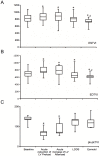Impact of acute changes of left ventricular contractility on the transvalvular impedance: validation study by pressure-volume loop analysis in healthy pigs
- PMID: 24260431
- PMCID: PMC3834044
- DOI: 10.1371/journal.pone.0080591
Impact of acute changes of left ventricular contractility on the transvalvular impedance: validation study by pressure-volume loop analysis in healthy pigs
Abstract
Background: The real-time and continuous assessment of left ventricular (LV) myocardial contractility through an implanted device is a clinically relevant goal. Transvalvular impedance (TVI) is an impedentiometric signal detected in the right cardiac chambers that changes during stroke volume fluctuations in patients. However, the relationship between TVI signals and LV contractility has not been proven. We investigated whether TVI signals predict changes of LV inotropic state during clinically relevant loading and inotropic conditions in swine normal heart.
Methods: The assessment of RVTVI signals was performed in anesthetized adult healthy anesthetized pigs (n = 6) instrumented for measurement of aortic and LV pressure, dP/dtmax and LV volumes. Myocardial contractility was assessed with the slope (Ees) of the LV end systolic pressure-volume relationship. Effective arterial elastance (Ea) and stroke work (SW) were determined from the LV pressure-volume loops. Pigs were studied at rest (baseline), after transient mechanical preload reduction and afterload increase, after 10-min of low dose dobutamine infusion (LDDS, 10 ug/kg/min, i.v), and esmolol administration (ESMO, bolus of 500 µg and continuous infusion of 100 µg·kg-1·min-1).
Results: We detected a significant relationship between ESTVI and dP/dtmax during LDDS and ESMO administration. In addition, the fluctuations of ESTVI were significantly related to changes of the Ees during afterload increase, LDDS and ESMO infusion.
Conclusions: ESTVI signal detected in right cardiac chamber is significantly affected by acute changes in cardiac mechanical activity and is able to predict acute changes of LV inotropic state in normal heart.
Conflict of interest statement
Figures




References
-
- Kass DA, Maughan WL, Guo ZM, Kono A, Sunagawa K, et al. (1987) Comparative influence of load versus inotropic states on indices of ventricular contractility: experimental and theoretical analysis based on pressure–volume relationships Circulation. 76: 1422–1426. - PubMed
-
- Kass DA, Yamazaki T, Burkhoff D, Maughan WL, Sagawa K (1987) Determination of left ventricular end-systolic pressure-volume relationships by the conductance (volume) catheter technique. Circulation 76: 1422–1436. - PubMed
-
- Burkhoff D, Mirsky I, Suga H (2005) Assessment of systolic and diastolic ventricular properties via pressure-volume analysis: a guide for clinical, translational, and basic researchers. Am J Physiol Heart Circ Physiol 289: H501–H512. - PubMed
-
- Lin HY, Freed D, Lee TW, Arora RC, Ali A, et al. (2011) Quantitative assessment of cardiac output and left ventricular function by noninvasive phase-contrast and cine MRI: validation study with invasive pressure-volume loop analysis in a swine model. J Magn Reson Imaging 34: 203–210. - PubMed
Publication types
MeSH terms
LinkOut - more resources
Full Text Sources
Other Literature Sources
Miscellaneous

